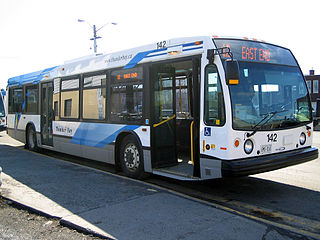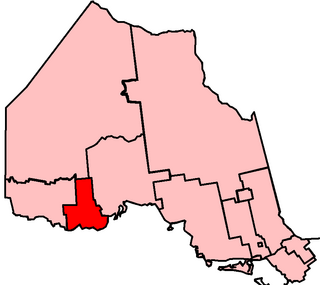
Thunder Bay is a city in and the seat of Thunder Bay District, Ontario, Canada. It is the most populous municipality in Northwestern Ontario and the second most populous municipality in Northern Ontario; its population is 107,909 according to the 2016 Canada Census, Located on Lake Superior, the census metropolitan area of Thunder Bay has a population of 121,621 and consists of the city of Thunder Bay, the municipalities of Oliver Paipoonge and Neebing, the townships of Shuniah, Conmee, O'Connor, and Gillies, and the Fort William First Nation.

Fort William was a city in Ontario, Canada, located on the Kaministiquia River, at its entrance to Lake Superior. It amalgamated with Port Arthur and the townships of Neebing and McIntyre to form the city of Thunder Bay in January 1970. Since then it has been the largest city in Northwestern Ontario. The city's Latin motto was A posse ad esse, featured on its coat of arms designed in 1900 by town officials, "On one side of the shield stands an Indian dressed in the paint and feathers of the early days; on the other side is a French voyageur; the center contains an [grain] elevator, a steamship and a locomotive, while the beaver surmounts the whole."
Port Arthur was a city in Northern Ontario, Canada, located on Lake Superior. In January 1970 it amalgamated with Fort William and the townships of Neebing and McIntyre to form the city of Thunder Bay.

Thunder Bay Airport,, is an airport in the city of Thunder Bay, Ontario, Canada. With 108,130 aircraft movements in 2012, it was the fourth busiest airport in Ontario and the 16th busiest airport in Canada. During the same year, more than 761,000 passengers went through the airport.

Thunder Bay is a large bay on the northern shore of Lake Superior, in Thunder Bay District, Ontario, Canada. The bay is about 50 kilometres (31 mi) long and 22 kilometres (14 mi) wide. It is bordered to the east by the Sibley Peninsula at the southern tip of which is Thunder Cape, marking the entrance to the bay for ships approaching from the east. The mesas and sills on the peninsula are known as the Sleeping Giant due to their appearance when viewed from Thunder Bay.

Fort Kaministiquia, was a French fort located on the north shore of Lake Superior at Thunder Bay, Ontario at the mouth of the Kaministiquia River. It and Grand Portage to the west were the starting points of the canoe route from the Great Lakes to western Canada. See Canadian canoe routes (early). Details of the route can be found under Kaministiquia River.

Thunder Bay Transit is the public transit operator in Thunder Bay, Ontario, Canada. It was formed in 1970, after the amalgamation of the cities of Port Arthur and Fort William and their respective transit agencies. Thunder Bay Transit is a member of the Canadian Urban Transit Association.

The Finnish Labour Temple is a Finnish-Canadian cultural and community centre and a local landmark located at 314 Bay Street in the Finnish quarter in Thunder Bay, Ontario.

The Thunder Bay Public Library serves the citizens of Thunder Bay, Ontario, Canada and surrounding areas.

Thunder Bay—Atikokan is a provincial electoral district in northwestern Ontario, Canada, that has been represented in the Legislative Assembly of Ontario since 1999.

Hillcrest High School was a high school in Thunder Bay, Ontario. It is part of the Lakehead District School Board system. The school was opened in 1928 as Port Arthur Technical School, and expanded several times in its history. The school's teams were named "Hillcrest Colts".

Current River is a neighbourhood located north east of Port Arthur in the city of Thunder Bay, Ontario. It is separated from the main urban area of Thunder Bay by the Current River Greenway, a large parkland along the river after which the neighbourhood was named. It is home to approximately 4,780 people and has an ageing and declining population.

Downtown Fort William, also known as Downtown Thunder Bay South or the South Core, is the urban core of the former city of Fort William, the southern half of Thunder Bay, Ontario. It is centred on Victoriaville Civic Centre, an indoor shopping mall and civic centre built as part of an urban renewal project in the 1980s. It is separated from the Kaministiquia River by the Canadian Pacific Railway line, and its topography is relatively flat.

Port Arthur Collegiate Institute was a collegiate institute operated by the Lakehead District School Board in Thunder Bay, Ontario from 1910 to 2007. The building was designated a historic building in 1984 and is located at the west end of Waverly Park. The school's teams were named "PACI Redmen". Its amenities included a gymnasium, a 200-seat theatre, a large library and a modern music room. The building was granted Historical Heritage Site status in 1983, and was transferred to Lakehead University in 2008. After extensive renovations, the building became home to Lakehead's Faculty of Law, and welcomed its inaugural class in September 2013.
The Western Dry Dock and Shipbuilding Company was a shipyard that operated at Port Arthur, Ontario, now part of Thunder Bay, on Lake Superior from 1911 to 1993. The shipyard was established in 1909 and renamed in 1916 as the Port Arthur Shipbuilding Company. The yard closed in 1993. It reopened as a repair yard Lakehead Marine and Industrial, however that venture failed in 2014. As of 2016, the shipyard was purchased by Heddle Marine. It is operated by Heddle Marine in partnership with Fabmar Metals Inc, of Thunder Bay. The venture focuses on ship repair services and winter layup options.

Marina Park is a local waterfront park and marina located on the shores of Lake Superior in Thunder Bay, Ontario. The park is located in the city's north end near the downtown north core. Aside from pleasure craft docks and a fueling facility, the park also has walking paths and a boardwalk, playground equipment, picnic tables, a Mariner's Monument and the historic CN Rail Station.

The Prince Arthur Hotel, now known as The Prince Arthur Waterfront Hotel is a hotel in Thunder Bay, Ontario. The hotel was originally built by the Canadian Northern Railway and was operated as a CN Hotel until 1955. The hotel was sold and now operates as an independent.

Leeblain is a ghost town in the Canadian province of Ontario, located on the north shore of Gunflint Lake in the Thunder Bay District. Part of the ghost town is located within La Verendrye Provincial Park and is adjacent to the well known Boundary Waters Canoe Area Wilderness in the Boundary Waters between Canada and the United States.

The North Lake is a former railway station located near North Lake, Thunder Bay District, Ontario. It lies close to La Verendrye Provincial Park and to the well known Boundary Waters Canoe Area Wilderness in the Boundary Waters between Canada and the United States. It was constructed in 1907 as a major station along the Port Arthur, Duluth and Western Railway.
HMCS Griffon is a Canadian Forces Naval Reserve Division (NRD) located in Thunder Bay, Ontario. Dubbed a stone frigate, HMCS Griffon is a land-based naval establishment for part-time sailors as well as a local recruitment centre for the Canadian Naval Reserve. It is one of 24 naval reserve divisions located in major cities across Canada.
















